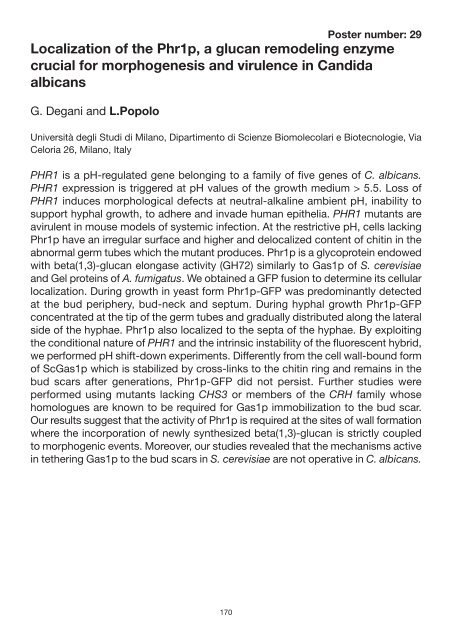Candida Infection Biology – fungal armoury, battlefields ... - FINSysB
Candida Infection Biology – fungal armoury, battlefields ... - FINSysB
Candida Infection Biology – fungal armoury, battlefields ... - FINSysB
You also want an ePaper? Increase the reach of your titles
YUMPU automatically turns print PDFs into web optimized ePapers that Google loves.
Poster number: 29<br />
Localization of the Phr1p, a glucan remodeling enzyme<br />
crucial for morphogenesis and virulence in <strong>Candida</strong><br />
albicans<br />
G. Degani and L.Popolo<br />
Università degli Studi di Milano, Dipartimento di Scienze Biomolecolari e Biotecnologie, Via<br />
Celoria 26, Milano, Italy<br />
PHR1 is a pH-regulated gene belonging to a family of five genes of C. albicans.<br />
PHR1 expression is triggered at pH values of the growth medium > 5.5. Loss of<br />
PHR1 induces morphological defects at neutral-alkaline ambient pH, inability to<br />
support hyphal growth, to adhere and invade human epithelia. PHR1 mutants are<br />
avirulent in mouse models of systemic infection. At the restrictive pH, cells lacking<br />
Phr1p have an irregular surface and higher and delocalized content of chitin in the<br />
abnormal germ tubes which the mutant produces. Phr1p is a glycoprotein endowed<br />
with beta(1,3)-glucan elongase activity (GH72) similarly to Gas1p of S. cerevisiae<br />
and Gel proteins of A. fumigatus. We obtained a GFP fusion to determine its cellular<br />
localization. During growth in yeast form Phr1p-GFP was predominantly detected<br />
at the bud periphery, bud-neck and septum. During hyphal growth Phr1p-GFP<br />
concentrated at the tip of the germ tubes and gradually distributed along the lateral<br />
side of the hyphae. Phr1p also localized to the septa of the hyphae. By exploiting<br />
the conditional nature of PHR1 and the intrinsic instability of the fluorescent hybrid,<br />
we performed pH shift-down experiments. Differently from the cell wall-bound form<br />
of ScGas1p which is stabilized by cross-links to the chitin ring and remains in the<br />
bud scars after generations, Phr1p-GFP did not persist. Further studies were<br />
performed using mutants lacking CHS3 or members of the CRH family whose<br />
homologues are known to be required for Gas1p immobilization to the bud scar.<br />
Our results suggest that the activity of Phr1p is required at the sites of wall formation<br />
where the incorporation of newly synthesized beta(1,3)-glucan is strictly coupled<br />
to morphogenic events. Moreover, our studies revealed that the mechanisms active<br />
in tethering Gas1p to the bud scars in S. cerevisiae are not operative in C. albicans.<br />
170


